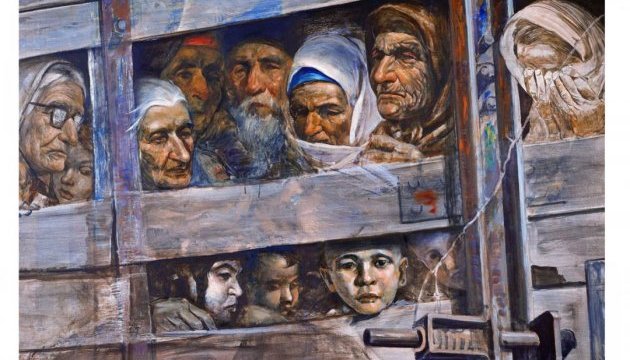
Crimean Tatars' Deportation: Was it Really First in 1944?
Thus, the rulers of the moscow tsardom and the russian empire repeatedly tried to capture and annex the territory of the Crimean Khanate. The interests of the russian autocratic monarchy in relation to the Crimean lands were first documented in 1767, when a report was prepared for empress Catherine II on her accession to the throne named as a note "On Little Tataria". It was not only about the fact that the Crimean Khan's troops made regular devastating raids on the southern borders of the empire, but also about the strategic importance of the peninsula for the development of Russia's economy/ There was provided a description of favorable climatic conditions for agriculture. After the annexation of Crimea by the russian Empire in 1783, Prince Golitsyn published a report entitled "What a Glorious Heritage", calling Crimea “a pearl in the crown of the russian empire”.
After the liquidation of the Romanov empire in 1917, the bolshevik government issued the Declaration of the Rights of the Peoples of Russia, which formally provided them a right to free national and state self-determination, and self-proclaimed governments began to form in Crimea. In Ukraine at that time, the Ukrainian Central Rada acted as the highest representative national governing body. According to its Universal of November 7, 1917, the creation of the Ukrainian People's Republic was proclaimed, which secured the territory of the former Tavriya province, with the exception of the Crimea. In the autumn of 1918, Hetman of the Ukrainian State P. Skoropadsky restored the rights of his state to the Crimea through diplomatic means.
After the proclamation of the soviet power in Ukraine in 1918–1919, the bolsheviks began to pursue a policy of “red terror” in Crimea, which reflected in fighting opponents of the new political regime. In 1920, an economic and political agreement was concluded between the soviet russia and Ukraine, which in fact marked the beginning of the creation of the ussr. The russian government, claiming a leading role in the all-union government, had to take care to ensure the commitment of the population of all territories of the newly created state. That is why the Crimean political elites were offered an option of autonomy, but with the condition that this was possible only within the Russian territory. Thousands of crimean tatars were returned to the Crimea and forcibly deported to the Far East during imperial times. Thus, in 1921, the Crimean Autonomous Soviet Socialist Republic was created as part of the russian SFSR. Prior to the legalization of the ussr in 1922, the leadership of the rsfsr first decided on the expediency of Crimea as part of the RSFSR given the ethnic composition of the population, and then, given the experience of self-proclaimed governments in Crimea in the postwar period, proscribed to grant this territory autonomous republic to gain the support of the local population. However, the geographical location of the Crimean Autonomous Soviet Socialist Republic contributed to the formation of close economic ties with the neighboring southern regions of the Ukrainian SSR, as well as with enterprises and institutions of other Ukrainian regions.
The date of May 18 for the Day of struggle for the rights of the Crimean Tatars was not chosen by chance. On this day in 1944 that the deportation of representatives of this people, as well as representatives of up to a dozen other nationalities living in Crimea, took place, allegedly on charges of "collaborationism". The total number of those deported at that time amounted to 228,390 people, through which the formal grounds for maintaining the autonomous republic and, accordingly, the prerequisites for establishing centers of the national movement were eliminated. A year later, the Crimean ASSR, which was an administrative part of the soviet russian republic, became the "ordinary" Crimean oblast. Since then, long years of struggle began for the return to their historical homeland of several generations of Crimean Tatars who lived in conditions of forced emigration and for a long time deprived of almost any opportunity to ensure their most elementary rights...
However, was it the first time in 1944 that such a large-scale eviction of the indigenous people of Crimea took place by decision of the russian authorities? Historical realities call this fact into question. Thus, a comprehensive study of the processes of incorporation of Crimea into the russian empire, and then soviet russia and the policy of the russian authorities in relation to the indigenous population of the peninsula, makes it possible to single out the following stages in the change in the national composition of the Crimean population:
• 1774–1779 – creation of prerequisites for the voluntary emigration of the Crimean Tatars on the eve of the occupation of the Crimean Khanate in 1783, the forcible destruction of individual settlements, bribery of local authorities in order to facilitate the eviction of the indigenous population and the settlement of these territories by ethnic Russians;
• 1783 – the beginning of the XIX century – the distribution of Crimean lands between Russian and foreign “colonists” and the liberation under this pretext of lands from indigenous people (the implementation of numerous bans on traditional crafts, due to which the local population has always lived, as a pretext for finding alternative sources of income outside the russian empire);
• 1820s – replacement of the Crimean Tatars by the "more loyal" peoples of the Balkans, who were forcibly resettled during the war with Turkey;
• 1854–1856 - the period of the Crimean War, the forced emigration of the Crimean Tatars to Western Europe and the Ottoman Empire;
• 1870s – creation of prerequisites for voluntary emigration of the Crimean Tatars to the Ottoman Empire;
• 1937–1944 - replacement of the indigenous Crimean Tatar population of the peninsula with Russian;
• 1944–1953 – organized resettlement of Russians and Ukrainians to the Crimea to restore the economy.
Remarkably, many "great russians" resettled in the Crimea according to planned orders, left the place of residence provided to them voluntarily. The reason for such a paradoxical phenomenon lies in the fact that the living and economic conditions in this region are fundamentally different from those characteristics of the central russian regions. At the same time, the closest economic ties between Crimea and Ukraine were typical for different historical stages. In particular, after World War II, Ukrainians started restoring the broken and plundered peninsula without any preliminary directives from Moscow officials. Moreover, local collective farms independently made plans to send the best specialists to rebuild the traditional branches of Crimean agriculture. For the first time the project for the construction of the North Crimean Canal was developed by Ukrainians in 1949.
The Kremlin authorities also repeatedly attempted to replace the recalcitrant Crimean Tatar population, as they claimed, with "more loyal ones". So, during the Russian-Turkish war of 1828–1829, when the Russian Empire “saved” the “fellow-believing and one-kind” peoples of the Balkans from under the dominion of the Ottoman Empire, Bulgarians, Greeks and Serbs were forcibly resettled on the territory of the peninsula, and in their place - Crimean Tatars. According to the Adrianople Treaty of 1829, those who agreed to resettle voluntarily were deprived of all their property in their homeland, and in their new place of residence they were provided with housing and land for cultivation. Formally, they retained the right to return to their country, but in this case, they would not have all that they had acquired during the forced emigration. In fact, people were left with no choice.
As we can see, only with a cursory calculation of the most large-scale manipulations of the Russian authorities with the ethnic composition of the Crimean population, the deportation of 1944 occupies the seventh line in their list. This fact testifies that, firstly, the “primordially Russian” status of Crimea is a myth that has been being painstakingly created during more than one century, and, secondly, even such repeated radical measures as eviction could not break the freedom-loving spirit of the Crimean Tatars and make them forget about the idea of recreating their own state on their native land. The subsequent decades spent by them far from their homeland, practically on the verge of survival, also did not erase from their memory who they really are and where their native land is located.
National Academy of the Security Service of Ukraine




